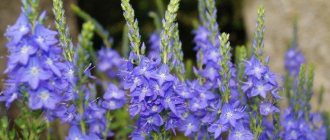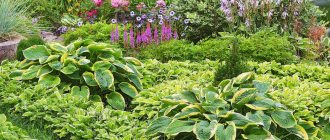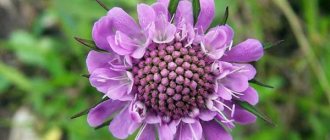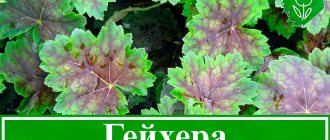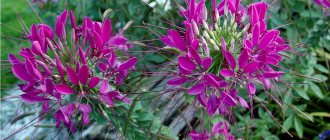The name of the genus Nerine is associated with the name of Nereus, the son of Gaia and Pontus, one of the most beloved gods of the watery sea element, and his daughters, the Nereids. Nereus and his oceanid wife Doris had fifty daughters (according to other sources, 51 or 100). The Nereids led a quiet life in the depths of the sea; on moonlit nights they appeared on the shore, sang songs and danced. Thus, nerine is often called the flower of nymphs. It is also known as the Guernsey Lily and the Cape Flower.
The name “Japanese Spider Lily” does not refer to nerina, as many people write, but to higanbana (Lycoris radiata) - this is a bulbous plant from the Liliaceae family, widespread in Japan and very popular there.
BRIEF INFORMATION ABOUT NERINE
Name: nerine or nerina Latin name: Nerine Nerine's homeland: For many years it was believed that nerine came from Japan, but its native home is South Africa, the Drakensberg Mountains. Description: Bulbous plants 30–50 cm high, with racemose inflorescences, most often pink, appearing before the leaves. Peculiarities of growing nerine: In the middle zone it is grown indoors; in summer it can be taken out into the open air. In the southern regions, it can be planted in the garden, leaving it to winter in open ground (climatic zone 8). Nerine's dormant period: Nerine has two dormant periods: the first occurs in winter, after flowering ends, and the second in summer, from May to August.
Popular varieties and types of nerine with photos, planting, cultivation and care, reproduction
Among the numerous Amaryllis family there is an unusual flower - nerine. The plant owes its romantic name to the mythical nymph – Nereis.
This representative of the flora has several other names - spider lily and African lily.
The content of the article:
1. Description of the plant 2. Varieties of flowers of nerine 2.1 Nerine Bowden 2.2 Nerine bashful 2.3 Nerine sarney 2.4 Nerine angustifolia 2.5 Nerine sinuous 2.6 Nerine Hutton 2.7 Nerine low 3. Planting and care in open ground 4. Methods of propagation of nerine 4.1 Reproduction by tubers 4.2 Reproduction seeds 5 How to care in open ground 6. Nerine pests 7. Planting and care at home
Description of the flower
Nerina (nerine) is a heat-loving bulbous plant native to South Africa. The flower belongs to the Amaryllis family. The genus has thirty species. The flower has the same name as an ancient Greek nymph.
A distinctive feature of the plant is the presence of long, dark green, belt-shaped leaves. The umbrella-shaped inflorescence has seven to fifteen flowers. Each has six strongly curved petals with wavy edges. Thanks to this structure of the flower, the erect stamens are clearly visible.
Due to the bizarre shape of the petals, nerina received the name “spider lily”. The flowers have different shades: pink, scarlet, crimson, white. They resemble segments of a bowl cut into pieces.
The inflorescence stem is leafless and is called the “naked woman.” For almost all varieties, the flowering period occurs in late summer or early autumn and lasts about two months. The dormant period occurs in the summer months. The exception is Bowden's nerine. The leaves of this ornamental plant appear later than the inflorescences.
In open ground conditions, the flower is grown only in warm climates with moderate rainfall. Excessive moisture is detrimental to the plant. Cut flowers are used to make bouquets. For three weeks they retain their original appearance.
Nerine - description of the plant
The plant is a perennial
and has a bulbous root system. On the long stem of the peduncle, an inflorescence is formed in the form of a basket, on which 5-20 buds bloom. The height of the peduncle can reach 50 cm.
Photo of Nerine flower
Nerine foliage has a structure characteristic of most lily plants - narrow ribbon-like leaf plates of a dark green color.
The inflorescences form a pleasant, original sight - delicate outwardly curved petals and long stamens in the center of the flower. The color of the buds can be white, scarlet, pink, orange or crimson. The funnel-shaped bud is 4-5 cm in diameter.
Description of Nerine - video
Nerine Bowden - what kind of plant
Bowden's nerine is a bulbous plant that is widespread among gardeners. It is frost-resistant and can be used as a garden plant. The article will tell you about its types, care features and methods of reproduction.
This bulbous flower originates from South Africa, but, thanks to its beauty, it quickly spread throughout the world as a garden crop.
Bowden's Nerine or Spider Lily as it is also called is a flower with linear narrow leaves of a dark green color. The plant stem reaches a height of half a meter. At the end of the bare stem there is an umbrella-like inflorescence, which is formed simultaneously with the leaves.
The umbrella of Nerine inflorescences is represented by a pair of funnel-shaped flowers of white, red, pink or even deep crimson colors.
The plant bulb is 3–5 cm in diameter.
The flowering period is early September and October. Depending on climatic conditions, it can be grown both as an indoor and garden plant.
Varieties of Nerine flowers
In the world, according to various sources, there are from 10 to 30 species of nerine, including plants grown indoors.
Types of Nerine:
- Bowden;
- bashful;
- Sarney;
- narrow-leaved;
- tortuous;
- Hutton;
- wavy;
- low.
Nerine Bowden
The most famous and popular species is Bowden's nerine.
Brief review of Nerine Bowden - video
This species is easier to grow in the garden due to its resistance to cold.
The bulbous tuber reaches 5 cm in diameter.
Often forms children around itself. Often, children, growing in size, are able to exist independently. A beautiful inflorescence contains 6-12 buds that look like a delicate flowing bell with dissected petals. Bowden's nerine flowers have a delicate scent. The time for flowering begins in October.
Nerine bowdenii has an elongated tuber. The length of the belt-shaped leaves is 30 cm with a width of 25 mm. The height of the peduncle is 45 cm. The curved petals are often painted in lilac tones.
Nerine the bashful
The shy spider lily is a valuable ornamental plant.
There are very few buds in the inflorescence of shy nerina (5-6).
The petals are drooping, which explains the romantic name of the species. Blooms white.
Nerine pudica is endowed with a rounded tuber, the diameter of which is only 3 cm. The foliage is belt-shaped, green in color with a silvery tint.
Nerine sarney
Nerine sarney has a rich color palette. This species was used as a base for breeding hybrid varieties.
Nerine angustifolia
Nerine angustifolia is almost devoid of foliage, but is distinguished by a long peduncle.
Inflorescences with curled petals with wavy edges are colored pink and lilac.
Nerine winding
The African lily is a rare specimen, with delicate and frilly petals of white or pink flowers.
Nerine Hatton
This lily is endowed with narrow green foliage and small pink inflorescences, which create a picture of abundant blooms due to a significant number of flowers.
Nerine wavy
The African wavy lily differs from other species in its straight foliage and peduncles,
on which 8-10 red or pink buds bloom.
Nerine low
The low lily develops a peduncle and foliage at the same time.
One peduncle of low nerine can contain about 20 buds of red or pink color with pointed petals. The height of the plant is only 30 cm.
Popular varieties of Nerine low:
- Rushmere Star
with bright pink petals and black anther; - Blanchefleur
with white delicate petals and stamens; - Lyndhurst Salmon
is a muted pink color with a longitudinal stripe down the center of the petal.
Possible problems with Nerine:
- Amaryllis scales can settle under the scales on bulbs. This is an oval insect, 3.5 mm long, covered with white wax. Severely affected bulbs have to be destroyed. Plants that can still be saved should be sprayed with Actellica suspension (2ml/l)
- Scale insects appear most often on the upper side of leaves along the veins. Later they spread to other parts of the plant. The scutes are greenish-yellow, 3-4mm in length. You can get rid of scale insects by mechanically cleaning the leaves. The plant is also wiped with a 7o-degree alcohol solution (you can just use vodka) or sprayed with an Actellica suspension (2ml/l)
- Red burn (staganospora) This is the most common disease of bulbs. Red spots appear on the bulbs - at first they are small stripes, later they grow and spread to the leaves and peduncles. The disease ultimately leads to ulceration of the bulb, deformation of leaves, and underdevelopment of peduncles. At the first appearance of red stripes on the bulbs, the plant is sprayed with a Fundazol suspension (2g/l). If the disease has gone far, you also need to prepare a special “coating” - 300 g of chalk, 15 g of copper sulfate, 30 g of OP-7 adhesive and add water so that the total volume reaches 1 liter. The composition is coated with the bulbs and bases of peduncles.
Nerine: planting and care in open ground
From the second name of nerine, the place of origin becomes clear. This is the continent of South Africa. The homeland of this bulbous plant determines the basic care requirements.
Nerine care - video
A place for bulbous plants is selected in a sunny, elevated position. Nerina needs diffused sunlight. Excess moisture and draft winds are harmful to it.
The composition of the soil should be loose with the addition of sand. The content of peat, humus or compost is welcome.
Provided the soil has a clay structure, a drainage layer is created. This measure will protect the bulb from rotting.
Growing Nerine
Nerine is a capricious plant. If all care requirements are not met, it will be difficult to wait for flowering. So lovers of exotic things have to try to bring indoor conditions closer to natural ones.
The first and most important condition is temperature. The room should be no warmer than 10-11 degrees in the autumn-winter period. For the human body, this temperature will be low. Therefore, nerine is contained using several options.
- One option: use an insulated balcony or loggia.
- Second option: if there is a free room in a house or apartment in which the temperature can be adjusted, then they grow it there.
- And now the third option. Since November, nerine no longer blooms, and they gradually stop watering it.
In mid-December, the leaves are almost dry; they are cut off along with the remains of the peduncle. The pot, along with the remaining onion, is removed to a cold place until the beginning of March. The overwintered nerine is brought back, but only immediately placed in an intermediate room, with a temperature of 3-4 degrees.
For adapting bulbs in a pot. In April, the bulbs will throw out leaves, which will dry out in June, because the plant will begin its second hibernation.
The bulbs will wake up in early September, immediately throwing out leaves, peduncles and buds. Almost a month later, two months of flowering begins.
Nerine propagation methods
There are two effective ways to propagate African lilies - seed and bulbous.
Reproduction of nerine by tubers
There will be no difficulties with the bulbous propagation method for nerine. It is necessary to remove the baby bulbs growing around the mother tuber from the soil and lightly dry them in the fresh air. After some time, nerine is planted in open ground. In this case, the bulb is not completely immersed in the soil, but only so that the upper part of the tuber is exposed to air. The planting is moistened and covered with mulch.
Photo of Nerine propagation by tubers
Nerine breeds in mid-summer or early August.
It is necessary that the tuber has time to gain strength and take root normally before October. The first flowering may occur this year, but it will be scanty.
Nerine - propagation by seeds
To use the method of propagating nerine by seeds, you will need to be patient. And nerine will bloom only 3 years after sowing the seeds.
Photo of propagation of nerine by seeds
Nerine seeds mixed with dry sand are sown in a container with fertile soil. Experienced gardeners use vermiculite for these purposes. After sowing and moistening, the container is covered with glass and placed on a lighted windowsill. The ambient temperature should be within +22C.
The glass is periodically removed for ventilation. The first shoots should appear on days 15-18, after which the glass is removed. The third leaf that appears is a signal that it is time to plant the seedlings. At the same time, the ambient temperature can be reduced by +5C, as well as the quality of natural light. Then the plants are grown for 3 years, without providing them with a rest period.
GOOD VARIETIES OF FLOWERS!
Park rose Louis Audier Rose Decor Harlequin Rose Frederic Mistral
In open ground, nerine can be grown with almost no problems. It can easily withstand low temperatures down to -12C.
In cold regions, the bulbs are removed from the soil with an earthen lump and sent for storage in a cold place. In spring the plant returns to the garden.
Important!
The African lily has two dormant periods per year – winter and summer. In winter, baby bulbs are laid, and in summer, the lily gains strength to bloom.
As a place for winter storage of tubers, you can consider a glazed loggia or balcony, where the bulbs will be kept in a box with peat.
An alternative storage location is the bottom shelf of the refrigerator.
Reproduction
Today, Nerine propagation is practiced in two ways:
- with the help of daughter bulbs;
- using seeds.
Both methods are effective - the main thing is to follow some rules for planting a flower.
Seeds
It is necessary to sow seeds in small and shallow containers with soil. It is best to plant in vermiculite. Since seeds usually do not germinate well, they need to be buried in the soil immediately after harvesting. There should be an interval of 2-3 centimeters between them . After sowing, the soil should be moistened with a spray bottle, and then the container with soil should be covered with glass or thin film. You can expect germination in 2-3 weeks.
The room temperature is of particular importance - it should be at least +22 degrees. It is also important to occasionally ventilate the planting material, which will help young plants avoid rotting.
You can plant the shoots after several leaves form on the stem and the stem itself becomes stronger.
Bulbs
It is best to separate the bulbs from an adult plant in the spring when replanting nerine. To do this, you need to carefully pull out the rhizome, clean it from the ground and separate several bulbs on which the roots will be present. They should be immediately transplanted into separate pots (small in diameter), and care should also begin as for an adult crop.
How to care for nerine in open ground
During dormancy, the bulbs do not need watering
. When the plant blooms, it should be moistened carefully, avoiding stagnation of moisture. Nerine prefers diffused sunlight as lighting. Direct scorching rays will be destructive for the lily.
Photo of nerine in open ground
It is necessary to feed the nerine plant twice every 30 days.
Any complex compositions for flowering plants will be suitable. In this case, overly concentrated solutions should be avoided.
Important!
Since the flower comes from the tropics, it prefers moist air. It is recommended to organize gentle spraying.
BEAUTIFUL FLOWERS!
Weigela: photo, planting and care Hydrangea Gloxinia
Spider lily is planted in open ground at the end of July or beginning of August.
It is worth maintaining a distance of up to 7 cm between adjacent bulbs. The plant does not require any special care, the main thing is to remove weeds and moisten it during flowering.
It is not recommended to plant nerine in lowlands.
Nerina Bowden
This is one of the varieties of the flower. Its bulb is capable of producing a large number of children. The green leaves are long, fifteen to thirty centimeters. Their surface is glossy, with small grooves.
The peduncle reaches a length of forty-five centimeters. The inflorescence is large, umbrella-shaped, its length is twenty-four centimeters. There are up to twelve flowers in an inflorescence. They are mounted on triangular legs, up to six centimeters in length. The flowers are pink.
Pleases with the lush flowering of Bowden's nerine. Planting and care require compliance with certain requirements for lighting, temperature, watering, humidity and fertilizing. This variety is the most cold-resistant flower of its kind.
Pests of Nerine
This attractive plant can be seriously damaged by mealybugs or aphids.
To prevent pest attacks, you can spray with a soap solution.
In difficult situations, special preparations against harmful insects are used. In most cases, Nerine is disease resistant. The plant can suffer from the wrong place in the garden or illiterate care.
Sometimes it can suffer from viral mosaic disease.
The African lily is attractive to local flower growers because its flowering time begins in October.
when other plants are already entering a dormant period.
Important!
Flower growers should be careful when caring for this lily, because its juice is poisonous. For this reason, you should keep this perennial away from children and pets, and wash your hands thoroughly after gardening.
This late-blooming perennial is a desirable resident of flower beds. Regions with mild climates and warm winters are suitable for growing outdoors. Where the climate is harsh, it is recommended to grow nerine indoors, and only keep it on a balcony, loggia or open veranda in the summer.
Diseases and pests
A positive aspect of this plant is that it is practically resistant to viral diseases. More often, the flower suffers from improper care and attack by mealybugs, which feed on the sap of the plant. Signs that affect a flower include the appearance of black mold on its leaves, but in this case this is already considered an advanced situation.
Before treating the affected leaves with an insecticidal preparation, you should wipe them with water and laundry soap , and then wipe them with a paper towel.
Leaves that have begun to wilt should not be removed - they should fall off on their own. After all, while they remain on the stem, they feed the bulb, which will need useful substances during the winter rest.
To prevent bulb rot during the dormant period, nerine does not need much or frequent watering. It is also not recommended to frequently feed the flower, as this will lead to increased leaf growth and poor flowering.
Nerine: planting and care at home
It is recommended to awaken the bulbs before planting.
When kept indoors, in March the tubers are removed from their storage place (refrigerator), immersed in the ground and kept at +23-25C until the end of summer.
Once a bronze tint appears at the top of the tuber, it will be possible to judge that it is awakening and ready for planting. After this, it is worth replacing the soil with fresh one and moistening the planting. After 20-30 days, flower stalks should appear.
Up to 2 tubers can be planted in one flower container with a diameter of 13 cm.
There is another planting method, where a significant number of tubers are planted around the perimeter in one container, while leaving a small distance from each other (3 cm). African lily bulbs planted in this way will allow you to enjoy active flowering, but they will not reproduce in such close quarters.
Good to know!
The recommended soil composition is slightly acidic and loose. A drainage layer in a flower container is required.
Useful article:
How to improve the soil, its fertility, composition, structure
When the growing season begins, the plant should be provided with 12 days of light.
Watering at this time should be moderate. The top layer of soil in the flower pot should have time to dry completely. When flowering stops, the frequency of watering should be reduced, and after the above-ground part dies off, watering should be stopped completely.
During flowering, the plant needs support. Therefore, fertilizers should be applied every 14 days for amaryllis flora.
This extraordinary plant requires a little more attention due to its two dormant periods.
So, after flowering, it is necessary to remove dry leaves and store the tubers for storage. This is the first period of rest. Nerine’s second “vacation” occurs in May-August.
Planting rules and propagation
The basic landing rules include:
- You cannot trim the green leaves of the plant;
- The diameter of the pot should not exceed 13 cm;
- Excessive watering before germination is not recommended;
- You should not replant Nerina more than once every four years;
- There must be a drainage layer at the bottom of the pot;
- It is important to regularly ventilate the room where the flower is located.
If all these rules are strictly followed, the flower will definitely live and will delight its owners with flowering.
Related article: Photos of Vriesia splendor (beautiful), perforate, giant, hieroglyphic, sanders and keeled
There are several ways to propagate a flower.
Reproduction through seeds
The seeds are mixed with sand before planting. Moistened vermiculite can act as a nutrient medium. The mixture is poured into a box and left for two to three weeks at a temperature of 22°C. After the seeds sprout, the temperature should be lowered to 14-18°C. Breeding Nerine from seeds is carried out for three years without interruption during dormancy.
Reproduction through children
To do this, when replanting in spring, it is enough to separate the small plants from the large bulbs and plant them in a separate container. In three to four years the young plant will bloom.
Despite the apparent hassle of growing Nerine, this plant is worth the effort. It will be a great addition to any gardener's collection.
Features of care
Rules regarding crop care will depend on the life cycle in which the Nerine is found. This directly relates to the season. It is worth highlighting the basic care recommendations for each period.
- In winter, the plant begins to lay flower buds, at which time the crop requires cool and dry air. The flower should be kept at a temperature of about +10°C. For these purposes, gardeners often send the plant to winter in the basement or loggia.
- With the arrival of spring , around March, the container with the flower can be moved to a lighted place indoors. During this period, the crop will increase its green mass. Watering should be moderate.
- In summer, nerine enters a dormant phase, in which it is necessary to remove dried green mass from it, and also gradually reduce moisture. The optimal room temperature during this period will be in the range of +23.25°C. Closer to August there comes a time when the plant will need moisture and fertilizing as the flower prepares to bloom.
- In September, the active growing season of the plant begins. The grower must provide good watering, as well as the introduction of fertilizers every 2 weeks. This especially applies to the time when a flower appears on the peduncle. For nerine, complex mineral formulations are suitable, which are best used in liquid form. Air humidity should not be increased; it is also worth protecting the crop from direct sunlight.
The plant takes a very long time to adapt after transplantation, so there is no need to replace the container too often.
To replace the soil, you can remove only the top layer of soil in the pot, replacing it with fresh one. It is best to carry out this work in summer or spring. The flower will be ready for transplantation only when it reaches 3 years of age.
